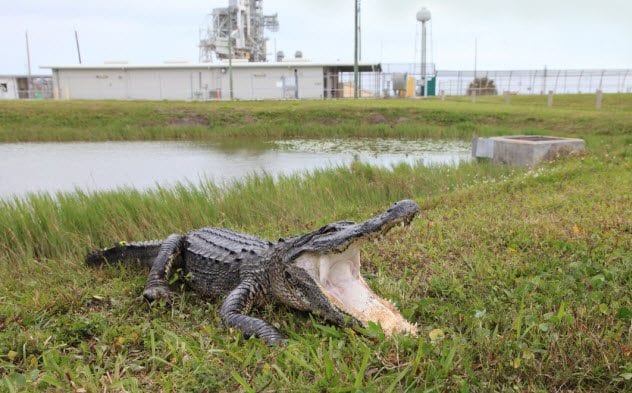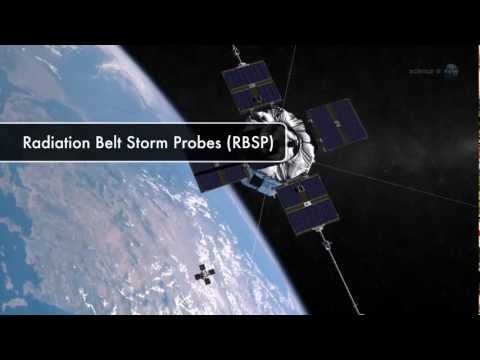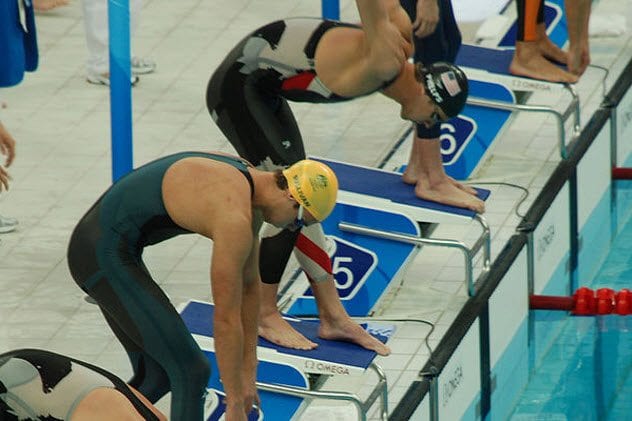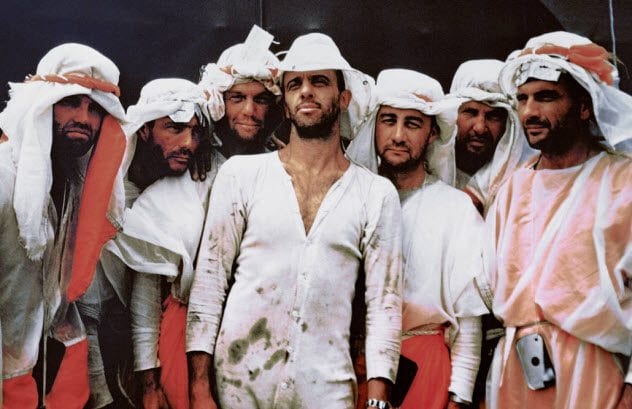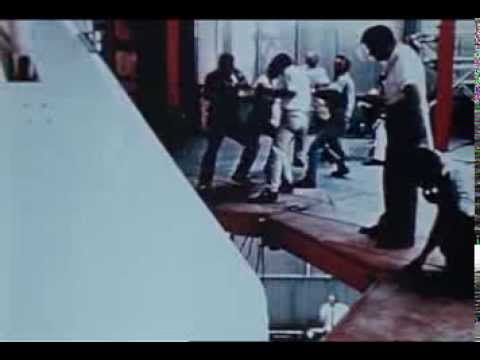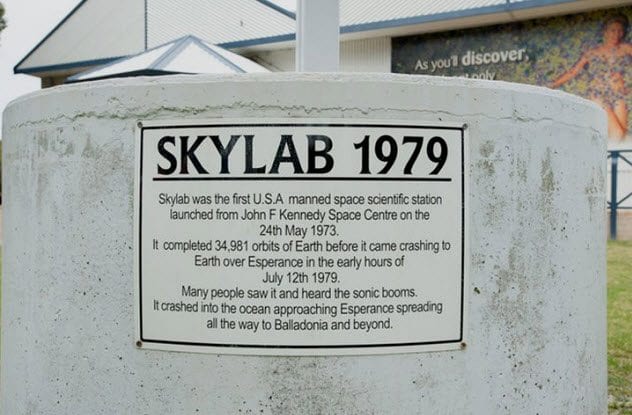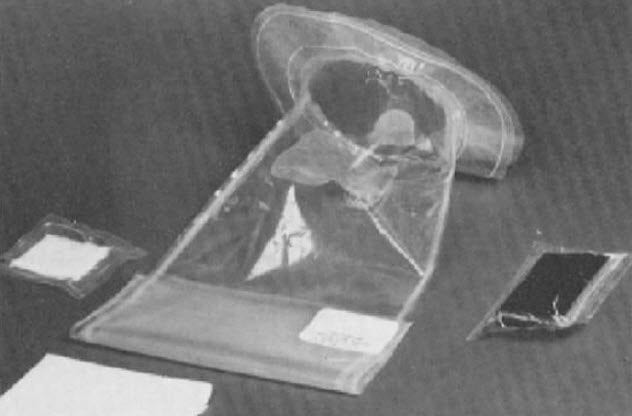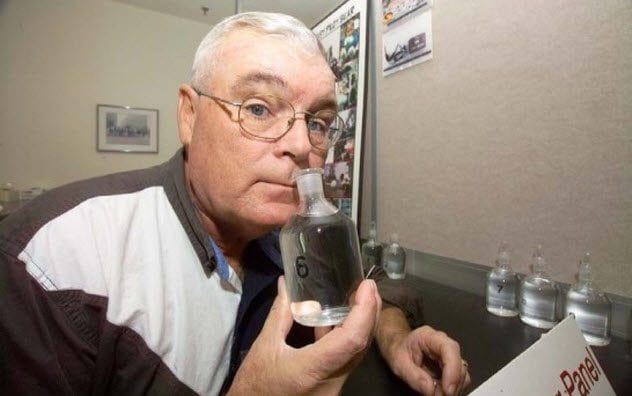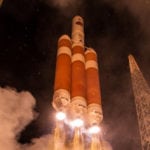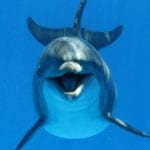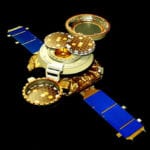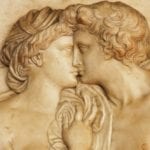10 NASA Has An Alligator Problem
Since 1968, NASA’s main launch site for spacecraft has been the Kennedy Space Center on Merritt Island. The island is also home to a national wildlife refuge which shares a natural border with the spaceport. This means that, occasionally, wildlife residents pay the flight center a visit. Most animals don’t really pose a problem for NASA. But one species that has caused a stir on multiple occasions is the American alligator. The island’s estuary has created an ideal environment for alligators, and fishing interdictions ensure that there’s a stable, sizable food source. The animals don’t have a reason to leave the area, but every now and then, they like to lounge around in the sun. They have been spotted in parking lots, on runways, and on streets. So far, the worst thing they’ve done was to briefly hold up traffic during rush hours. Not ones to miss an opportunity, scientists have begun to study the alligators. They see the reptile as a species indicative of the overall health of the wildlife refuge—a canary in the coal mine. As NASA uses new technology, components, and chemicals, they want to make sure that none of them are having an adverse effect on the environment.
9 NASA Recorded A Song By The Planet
Although it didn’t make the Billboard charts, an audio recording dubbed “Earthsong” that was “sung” by the planet itself was released by NASA in 2012. The recording was made by NASA’s twin Radiation Belt Storm Probes (now known as the Van Allen Probes) and features a phenomenon named chorus—radio emissions caused by plasma waves in Earth’s radiation belts. Watch this video on YouTube According to Craig Kletzing of the University of Iowa, who helped build the Electric and Magnetic Field Instrument Suite and Integrated Science receiver used to pick up the signals, the sound represents what we would hear in the radiation belts if humans had radio antennae instead of ears. He was also quick to note that the sound is not caused by acoustic waves but rather by radio waves oscillating at frequencies between 0 and 10 kHz. The main mission of the Van Allen Probes is to study the chorus, although the recording was just a fun little offshoot. Scientists are particularly interested in a phenomenon potentially caused by chorus emissions called “killer electrons.” These ultra-relativistic particles have the energy to pose a threat to anything that stands in their way, including spacecraft and astronauts.
8 NASA Designed The Perfect Swimsuit
NASA has always been open to partnerships with other brands to increase exposure and to find real-world applications for its many innovations. In 2004, NASA partnered with swimwear giant Speedo USA to help design a new swimsuit with reduced drag. NASA took advantage of its vast knowledge of aerodynamics and tested over 60 different fabrics in their wind tunnels to see which ones provided the least amount of drag. The end result was the LZR Racer (pronounced “laser”)—a full-body, fully bonded, ultrasonically welded swimsuit made of woven elastane-nylon and polyurethane. At the 2008 Beijing Olympics, athletes wearing the LZR Racer broke 23 world records. Fully 98 percent of swimmers who won medals did it in the NASA-designed swimsuit. A few months later at the 2008 European Short Course Championships, another 17 world records were broken. Eventually, the Federation Internationale de Natation decided the suit conferred too much of an advantage. New policies were introduced to restrict the maximal body area covered by the suit as well as the fabric used. This essentially prohibited swimmers from using the original LZR Racer design.
7 NASA Astronauts Require Wilderness Survival Training
Not anyone can become an astronaut. We all know that it requires a lot of dedication and hard work. But few probably realize just how extensive the training can be, even going as far as requiring astronauts to learn how to survive in the wilderness. Water survival exercises are an integral part of astronaut training. This makes sense since landing in water (“splashdown”) was standard practice until the development of the Space Shuttle program. However, the capsules don’t always land where they’re supposed to, and NASA likes to prepare for all eventualities. That’s why astronauts must also undergo specialized wilderness survival training, such as learning to live in the desert or the jungle for prolonged periods of time. This requirement dates all the way back to the original Mercury Seven astronauts in the early 1960s. They were trained at air force bases in Nevada and Panama. So far, none of the astronauts has had to rely on their wilderness skills. The biggest landing miscalculation occurred in 1962 when the Aurora 7, piloted by Mercury astronaut Scott Carpenter, landed 400 kilometers (250 mi) off course. The capsule still made it into the waters northeast of Puerto Rico and was recovered hours later by an aircraft carrier.
6 NASA Used The Shake Test
A common fun fact on the Internet says that the technology in your phone or your watch is more advanced than the one used to send man to the Moon. It’s a testament to the low-tech beginnings of NASA, which often had to rely on simple solutions to solve complex problems. It didn’t get more basic or more bizarre than the shake test. Rockets need to be tested to ensure that they can withstand the heavy vibrations experienced during launch. These spacecraft exert millions of pounds of thrust, and even one loose bolt can spell disaster. Nowadays, modern rockets like Orion have to contend with the world’s most powerful shaker—a vibrating table that is 7 meters (22 ft) wide and weighs 25,000 kilograms (55,000 lb) in the Plum Brook Space Power Facility. Each service module undergoes dozens of tests before being cleared for use. Back in the 1960s, things were decidedly more primitive. After Hurricane Alma, NASA scientists became concerned with what would happen to a rocket’s structural integrity if it was hit by strong winds on the launchpad. They didn’t have a fancy test for it, so the ground crew resorted to manually shaking the rocket to see what would happen. Some pushed against it with their legs while others tugged on a rope. That was the first NASA shake test. Turns out they needed a better way of securing the launch system rocket at the top of the stack. The rocket fell off. But luckily, it didn’t land on anyone.
5 NASA’s Massive Building Has Its Own Weather
NASA builds some of the largest vehicles in the world. So it stands to reason that NASA would need a large building for this purpose. In fact, the Vehicle Assembly Building (VAB) at the Kennedy Space Center is, by volume, the fifth largest building in the world. It is only behind other assembly sites such as those for Boeing and Airbus. The VAB has over 3.7 million cubic meters (130 million ft3) of interior volume. The building’s massive size combined with Florida’s humidity has created a unique problem—the VAB has its own weather. On the more humid days, clouds begin to form below the ceiling inside the building. Obviously, this poses a problem for a structure where billion-dollar spacecraft are built with the utmost precision and delicacy. NASA solved this issue with a 10,000-ton air conditioning system that prevents moisture from building up.
4 NASA Had An Unpaid Littering Ticket For 30 Years
In 1979, NASA generated a lot of media attention when Skylab, the first American space station, came crashing back down to Earth. Years after being abandoned by astronauts, Skylab had performed almost 35,000 orbits around our planet and was literally falling apart. NASA scientists decided it was time to get rid of Skylab once and for all. With a final shot of its rockets, the space station was blasted toward the Indian Ocean. Unfortunately, Skylab broke up upon reentry. While some parts landed in the ocean, most of the station crashed all over Western Australia. Nobody was hurt, but the Shire of Esperance fined NASA $400 for littering. The stunt was enough to get the tiny community of 14,000 people in the papers, but NASA never bothered to actually pay the fine. It wasn’t until 2009 that a California radio show host heard the story and raised the money to pay the outstanding fine.
3 NASA Has An Unsolved Turd Mystery
Waste management has always been one of space travel’s more unpleasant yet completely necessary subjects. Although modern astronauts use high-tech toilets, the first spacefarers had nothing more than plastic bags to tape to their butts. This led to an interesting discussion between the members of Apollo 10 on Day 6 of their mission. While orbiting the Moon, Commander Tom Stafford uttered the memorable phrase, “Give me a napkin quick. There’s a turd floating through the air.” Once he retrieved the item in question, Stafford asked where it came from. Both lunar module pilot Eugene Cernan and command module pilot John Young denied it was theirs. In the words of Cernan, “If it was me, I sure would know I was sh**ting on the floor.” Nine minutes later, the trio was interrupted by another floating piece of poop. They all dismissed the event with laughter, but none of them admitted the turds belonged to them. The mystery remains unsolved to this day.
2 NASA Employs A Team Of Sniffers
George Aldrich’s official position is chemical specialist with the Molecular Desorption and Analysis Laboratory of the White Sands Test Facility in New Mexico. George prefers to describe himself as a “nasalnaut.” He has an odd job—he has to sniff everything NASA plans to send into space for unpleasant or strange odors. According to Aldrich, confined spaces and heat bring out the smells of objects. When you’re in space, you can’t exactly open a window. So he has to ensure that none of the items sent aboard manned spacecraft emit any kind of unwanted odors. In 1974, the Soviets abandoned a Soyuz mission because they couldn’t account for a strange smell aboard the craft. More than that, a process called off-gassing could cause even odorless objects to emit dangerous, even deadly chemicals. George has served as NASA’s resident nose since 1974. Although he’s the “chief sniffer,” Aldrich is part of a smelling team dubbed the Odor Panel. To make sure that the sniffers are up to snuff, they are recertified every four months with a “10-bottle test” where they have to correctly identify the odor in each one.
1 NASA Once Had A Mutiny In Space
Working in space can get pretty stressful, and a lot of resources have been dedicated to studying how humans cope with the vast isolation of the universe. In 1974, the Skylab 4 crew spent 84 days in space, the longest stretch of time until that point. Turns out that it was too long as the three astronauts went on strike and staged the first (and only) mutiny in space. Actually, the protest happened over a month before the end of the mission. The strict schedule, the heavy workload, and the general stress of the job had taken their toll on the astronauts. So the trio decided to take an unplanned day off. They turned off radio communication with mission control and spent the day relaxing, enjoying Earth’s beautiful scenery viewed from orbit. A day later, the astronauts resumed communication and got back to work. NASA ground control wasn’t very happy, but there was little they could do about it. However, part of Skylab 4’s mission was experimenting with ways to overcome the problems of living in space. NASA was more concerned with the physical tolls on the body, but it learned a valuable lesson about the effect that space travel can have on the mind. No matter the training, NASA couldn’t treat astronauts just as data-gathering instruments. Since then, the agency has included activities to rest and to entertain the mind.
